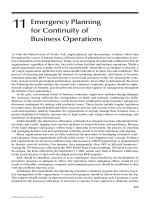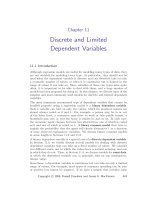Personality classic theories and modern research 6th chapter 11 mail femail differences
Bạn đang xem bản rút gọn của tài liệu. Xem và tải ngay bản đầy đủ của tài liệu tại đây (237.46 KB, 26 trang )
Personality
Sixth edition
Chapter 11
Male–Female
Differences
Copyright © 2015, 2012, 2009 Pearson Education, Inc. All Rights Reserved
Modules
Introduction: Male-Female Differences
11.1: Do Males and Females Differ?
11.2: A Brief History of Gender Difference in Personality
11.3: Biological Influences on Gender Differences
11.4: Gender Differences in Personality from the Eight
Perspectives
11.5: Cross-Cultural Studies of Gender Differences
11.6: Love and Sexual Behavior
Conclusion: How Is Personality Studied and Assessed?
Copyright © 2015, 2012, 2009 Pearson Education, Inc. All Rights Reserved
Learning Objectives (1 of 2)
11.1: Examine the physical and psychological
differences between males and females
11.2: Inspect the historical difference in the portrayal
of women and men
11.3: Describe how gender differentiation and
development occur biologically
11.4: Describe how the eight basic approaches to
personality address gender differences
Copyright © 2015, 2012, 2009 Pearson Education, Inc. All Rights Reserved
Learning Objectives (2 of 2)
11.5: Contrast the way gender differences are
perceived across cultures
11.6: Contrast the differences between men and
women in love and sexual behavior
Copyright © 2015, 2012, 2009 Pearson Education, Inc. All Rights Reserved
Introduction: Male-Female Differences
• Use of eight basic aspects of personality to
examine male–female differences
• Masculinity
• Femininity
Copyright © 2015, 2012, 2009 Pearson Education, Inc. All Rights Reserved
11.1: Do Males and Females Differ?
Objective: Examine the physical and psychological differences between males and females
• Differences between men and women
• Female characteristics
• Male characteristics
Copyright © 2015, 2012, 2009 Pearson Education, Inc. All Rights Reserved
Figure 11.1: Projected Life Expectancy at Birth in the United
States
As overall life expectancies in the United States and Canada (and the rest of the world) have
increased, women’s life expectancies have remained greater than men’s. The reasons for
this difference are still being researched, but in addition to biology, differences in
masculinity–femininity seem highly relevant. (Data are projections from U.S. Census
Bureau.)
Copyright © 2015, 2012, 2009 Pearson Education, Inc. All Rights Reserved
11.1.1: Evidence for Gender Differences
• Gender differences in the expression of two social
characteristics
• Gender differences in personality and behavior
Copyright © 2015, 2012, 2009 Pearson Education, Inc. All Rights Reserved
11.2: A Brief History of Gender
Difference in Personality
Objective: Inspect the historical difference in the portrayal of women and men
• Yin and yang
• Identification of women as not only different but
lesser
Copyright © 2015, 2012, 2009 Pearson Education, Inc. All Rights Reserved
11.2.1: Nineteenth-Century Views
• Functionalists’ views on women’s tasks
• Functionalists’ beliefs on maternal instinct
Copyright © 2015, 2012, 2009 Pearson Education, Inc. All Rights Reserved
11.3: Biological Influences on Gender
Differences
Objective: Describe how gender differentiation and development occur biologically
• Genetic sex
• Influences of female development
Copyright © 2015, 2012, 2009 Pearson Education, Inc. All Rights Reserved
11.3.1: The Effects of Prenatal Sex
Hormones on Gender Behavior
• Evidence of effect of prenatal hormones on
gender behavior
• Turner’s syndrome
Copyright © 2015, 2012, 2009 Pearson Education, Inc. All Rights Reserved
11.3.2: The Influence of Hormones
during and after Puberty
• Hyperandrogenism
• Cyclical oscillations in women’s hormones
Copyright © 2015, 2012, 2009 Pearson Education, Inc. All Rights Reserved
Figure 11.3: Cyclical Variation in Blood Levels of Estradiol in
Females
Estradiol, a form of estrogen, shows a distinctive pattern of variation over the course of the
menstrual cycle in premenopausal women, which is often related to mood and behavior. It
has been argued that these and related hormone swings help account for emotionality, as
well as females’ varying interest in sexual activity and varying appeal to men at different
times of the month.
Copyright © 2015, 2012, 2009 Pearson Education, Inc. All Rights Reserved
11.4: Gender Differences in Personality
from the Eight Perspectives
Objective: Describe how the eight basic approaches to personality address gender differences
• Physiological and biological gender differences
Copyright © 2015, 2012, 2009 Pearson Education, Inc. All Rights Reserved
11.4.1: The Psychoanalytic Approach
• Reasons for gender differences in traits
• Castration anxiety
Copyright © 2015, 2012, 2009 Pearson Education, Inc. All Rights Reserved
11.4.2: The Neo-Analytic Approaches
• Erikson’s views on male traits
• Erikson’s views on female characteristics
Copyright © 2015, 2012, 2009 Pearson Education, Inc. All Rights Reserved
11.4.3: Biological/Evolutionary
Approaches
• Natural selection
• Men engaging in sexual activity
Copyright © 2015, 2012, 2009 Pearson Education, Inc. All Rights Reserved
11.4.4: The Behaviorist Approach
• Behavioral learning techniques
• Gender – a salient characteristic
Copyright © 2015, 2012, 2009 Pearson Education, Inc. All Rights Reserved
11.4.5: The Cognitive Approach
• Gender schema theory
• Usefulness of gender schemas
Copyright © 2015, 2012, 2009 Pearson Education, Inc. All Rights Reserved
11.4.6: Trait Approaches to Masculinity
and Femininity
• Bem’s classification of individuals
• Achievement motivation
Copyright © 2015, 2012, 2009 Pearson Education, Inc. All Rights Reserved
11.4.7: Humanistic Approaches
• Maslow’s personality theory
• Reasons for women’s low dominance
Copyright © 2015, 2012, 2009 Pearson Education, Inc. All Rights Reserved
11.4.8: Interactionist Approaches
• Decoding verbal and nonverbal messages
• Overview
Copyright © 2015, 2012, 2009 Pearson Education, Inc. All Rights Reserved
11.5: Cross-Cultural Studies of Gender
Differences
Objective: Contrast the way gender differences are perceived across cultures
• Egoistic dominance
• Areas with no dependable gender differences
Copyright © 2015, 2012, 2009 Pearson Education, Inc. All Rights Reserved
11.6: Love and Sexual Behavior
Objective: Contrast the differences between men and women in love and sexual behavior
• Stereotypes in American society
• Gender-similar aspects of sexuality
Copyright © 2015, 2012, 2009 Pearson Education, Inc. All Rights Reserved









